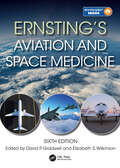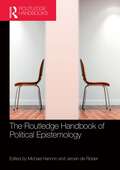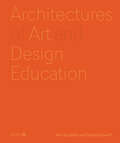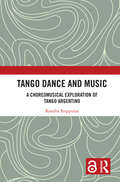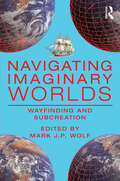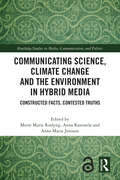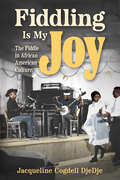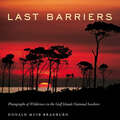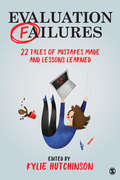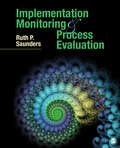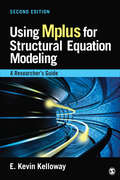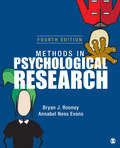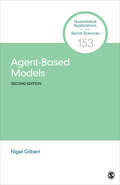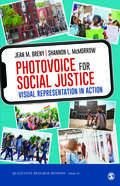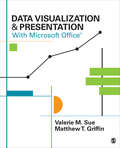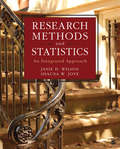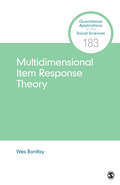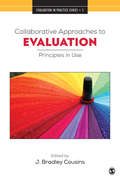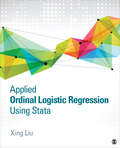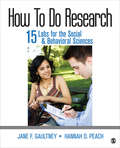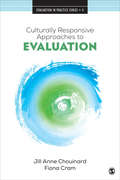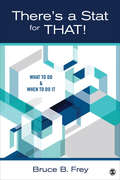- Table View
- List View
Ernsting's Aviation and Space Medicine
by David P. Gradwell Elizabeth S. WilkinsonErnsting's Aviation and Space Medicine applies current understanding in medicine, physiology and the behavioural sciences to the medical challenges and stresses that are faced by both civil and military aircrew, and their passengers, on a daily basis. The sixth edition of this established textbook and clinical reference has been revised and updated by a multidisciplinary team of experienced contributors, many new to this edition. The structure of the book has been refined, bringing related chapters together where appropriate, while the clinical content has been carefully streamlined in line with the specific requirements of the aviation medicine practitioner and adviser, with new chapters added on Commercial Space Travel, Skin Disease and Women’s Health.Key Features: Convenient – embraces all aspects of aviation medicine in a single volume, divided into four parts for ease of reference: Aviation Physiology & Aircrew Systems, Space Physiology & Medicine, Clinical Aviation Medicine and Operational Aviation Medicine Comprehensive – covers all forms of military and passenger-carrying aircraft, including issues surrounding passenger safety and transport of the sick and injured Aids detailed understanding – focuses on the principles underlying the standards in the field rather than just the standards themselves Applicable worldwide – addresses international issues, including worldwide regulation of medical standards, and travel and disease Accessible – chapter summaries enable rapid assimilation of key points while key references and suggestions for further reading encourage in-depth learning eBook included - text fully online and searchable via VitalSource eBook The text remains the recommended coursebook for those studying for the Diploma in Aviation Medicine of the Faculty of Occupational Medicine of the Royal College of Physicians, recognized worldwide as an exemplary standard in the field, and for similar worldwide qualifications. It is an essential companion for all civil and military aviation medicine practitioners, both when preparing for professional examinations and in daily practice, and for those in the many disciplines of the behavioural and life sciences that include some study of aviation, its physiology and related issues. It is also recommended reading for those with a wider interest in the medical problems of professional or recreational flying, air transport and the aviation industry.
The Routledge Handbook of Political Epistemology (Routledge Handbooks in Philosophy)
by Jeroen De Ridder Michael HannonAs political discourse had been saturated with the ideas of "post-truth", "fake news", "epistemic bubbles", and "truth decay", it was no surprise that in 2017 The New Scientist declared: "Philosophers of knowledge, your time has come." Political epistemology has old roots, but is now one of the most rapidly growing and important areas of philosophy.The Routledge Handbook of Political Epistemology is an outstanding reference source to this exciting field, and the first collection of its kind. Comprising 41 chapters by an international team of contributors, it is divided into seven parts: Politics and truth: historical and contemporary perspectives Political disagreement and polarization Fake news, propaganda, and misinformation Ignorance and irrationality in politics Epistemic virtues and vices in politics Democracy and epistemology Trust, expertise, and doubt. Within these sections crucial issues and debates are examined, including: post-truth, disagreement and relativism, epistemic networks, fake news, echo chambers, propaganda, ignorance, irrationality, political polarization, virtues and vices in public debate, epistocracy, expertise, misinformation, trust, and digital democracy, as well as the views of Plato, Aristotle, Mòzǐ, medieval Islamic philosophers, Mill, Arendt, and Rawls on truth and politics.The Routledge Handbook of Political Epistemology is essential reading for those studying political philosophy, applied and social epistemology, and politics. It is also a valuable resource for those in related disciplines such as international relations, law, political psychology, political science, communication studies, and journalism.
Architectures of Art and Design Education: An exploration of UK and international design schools
by Neil Drabble Rose GridneffThe art school has had a fundamental effect on society internationally, influencing how the creative arts are represented and perceived. At a time that funding in the UK is placing arts education in crisis, this is the first book of its kind to investigate the concept of the 'art school' and its social impact and legacy. It highlights how the physical studios and workshops, designed for learning, teaching and making, influence and interact with the curriculum, creativity and practice. Beautifully illustrated, with both archival and contemporary photographs, many taken by the authors, this book celebrates the spaces dedicated to learning and teaching creative disciplines. Exploring a drastically shifting landscape in higher education, it celebrates the crucial relationship between the creative working spaces and the development of creative minds. A timely reflection on the current social and political climate, this book emphasises the significant role that the art school has to play in society, developing thriving creative industries and a wider culture of the arts.Featured art schools include: Chelsea College of Arts Government College of Art, Chandigarh The Bauhaus Escuelas Nacionales de Arte (ENA), Cuba Manchester School of Art.
Tango Dance and Music: A Choreomusical Exploration of Tango Argentino
by Kendra StepputatThis book investigates choreomusical aspects of tango argentino in translocal practice, in particular its current manifestation in Europe. It looks at translocal tango argentino in its many facets: movement structures, sound structures, dancers and musicians, and the complex relations between these factors that all have their share in shaping the practice. Beyond being the first extensive monograph about translocal tango music and dance, the book crosses borders in the use of both qualitative and quantitative methods, ranging from participant observation to statistical data evaluation, including optical motion capture for movement analysis. The book contains a brief historical overview of tango argentino practice in the twentieth century, bringing together the development of music and dance in a holistic way to better understand the background of the current interconnectedness. The first main part of the book focuses on the “danceability” aspect of tango music. The exploration is based on tango DJs’, tango dance teachers’, and tango musicians’ view of tango danceability as well as experimental approaches. The second part is dedicated to tango dance and its “musicality”. It investigates with quantitative and qualitative methods tango movement repertoire and principles and how these relate to tango musical features.The Open Access version of this book, available at http://www.taylorfrancis.com, has been made available under a Creative Commons [Creative Commons Attribution-NonCommercial-ShareAlike (CC-BY-NC-SA)] license.
Navigating Imaginary Worlds: Wayfinding and Subcreation
by Wolf, Mark J. P.This edited anthology offers a collection of essays that each look at various types of wayfinding. Together they explore a variety of wayfinding tools and techniques and their applications, as well as ways of keeping track of the construction of worlds too.With transmedial worlds extending over multiple media, multiple authors, and sometimes even multiple decades of creation, a wealth of different issues can arise; worlds need to direct audience members into how to organize them conceptually. Edited by Mark J. P Wolf and featuring contributions from a distinguished set of authors from interdisciplinary backgrounds, this book enriches the theory, history, and practice of world-building, through the exploration of navigation. The essays have many overlapping concerns and together they provide the reader with a range of discussions regarding wayfinding and the many ways it intersects with world-building - and world-experiencing - activities. Thus, rather than just analyzing worlds themselves, the anthology also asks the reader to consider analyzing the act of world-building itself.This collection will be of interest to students and scholars in a variety of fields including Subcreation Studies, Transmedia Studies, Popular Culture, Comparative Media Studies, Video Game Studies, Film Studies, and Interdisciplinary Literary Studies.
The New Luxury: Individuality, quality and sustainability in interior design
by Dean KeyworthThis book explores what 'luxury' in interior design means today and how to achieve it, and provides inspirational examples of projects from a range of designers that meet the parameters of quiet luxury. Like many other sectors, interior design can be polarised: the luxury, unattainable end, and the cheap and cheerful lower end.This book disregards this dichotomy and shows how designers can avoid a throw-away culture, cleaving to that idea of longevity and high-quality above the cheap and flimsy, even for those with smaller budgets. Illustrated with beautiful examples of projects, this is a book that showcases how interior designers and homeowners alike can achieve an interior space that prioritises quality and sustainability on every kind of budget, focusing on quality fabrics and materials, sustainable credentials and complementary tones.
Communicating Science, Climate Change and the Environment in Hybrid Media: Constructed Facts, Contested Truths (Routledge Studies in Media, Communication, and Politics)
by Anna Rantasila Mette Marie Roslyng Anna Maria JönssonThis volume examines how a new hybrid mediascape represents and contributes to the construction of facts and knowledge in relation to science, environment, and climate controversies, providing a new, critical perspective to the bourgeoning field of science and environment communication.Arguing that science must be understood from an inclusive perspective, respecting public values and concerns alongside scientific arguments, the authors demonstrate how this will allow us to properly understand the role of science, truth, and factuality alongside the ethical, cultural, and political concerns about science raised in different publics. The chapters focus on the more controversial aspects of science and environmental communication: misinformation, public understandings of science and the environmental crises, vaccination, and the role of the hybrid mediascape in science, environment, and climate conflicts.Offering a much-needed interdisciplinary approach to understand the role of science of media in science and environment conflicts, this book will appeal to students and academics in the areas of media and communication, journalism, cultural studies, science, environment and risk communication, and digital media studies, as well as sociology and political science.The Open Access version of this book, available at www.taylorfrancis.com, has been made available under a Creative Commons Attribution-Non Commercial-No Derivatives (CC-BY-NC-ND) 4.0 license. An electronic version of this book is freely available, thanks to the support of libraries working with Knowledge Unlatched (KU). KU is a collaborative initiative designed to make high quality books Open Access for the public good. The Open Access ISBN for this book is 9781003479550. More information about the initiative and links to the Open Access version can be found at www.knowledgeunlatched.org.
Fiddling Is My Joy: The Fiddle in African American Culture (American Made Music Series)
by Jacqueline Cogdell DjeDjeIn Fiddling Is My Joy, Jacqueline Cogdell DjeDje examines the history of fiddling among African Americans from the seventeenth to the mid-twentieth century. Although music historians acknowledge a prominent African American fiddle tradition during the era of slavery, only recently have researchers begun to closely examine the history and social implications of these musical practices. Research on African music reveals a highly developed tradition in West Africa, which dates to the eleventh or twelfth century and continues today. From these West African roots, fiddling was prominent in many African American communities between the seventeenth and nineteenth centuries, and the fiddle became an important instrument in early twentieth-century blues, jazz, and jug bands. While less common in late twentieth-century African American jazz and popular music groups, the fiddle remained integral to the musicking of some Black musicians in the rural South.Featured in Fiddling Is My Joy is access to a comprehensive online eScholarship Companion that contains maps, photographs, audiovisual examples, and other materials to expand the work of this enlightening and significant study. To understand the immense history of fiddling, DjeDje uses geography to weave together a common thread by profiling the lives and contributions of Black fiddlers in various parts of the rural South and Midwest, including the mountains and along the Atlantic and Gulf coasts. In addition to exploring the extent that musical characteristics and aesthetics identified with African and European cultures were maintained or reinterpreted in Black fiddling, she also investigates how the sharing of musical ideas between Black and white fiddlers affected the development of both traditions. Most importantly, she considers the contradiction in representation. Historical evidence suggests that the fiddle may be one of the oldest uninterrupted instrumental traditions in African American culture, yet most people in the United States, including African Americans, do not identify it with Black music.
Last Barriers: Photographs of Wilderness in the Gulf Islands National Seashore
by Donald Muir BradburnRarely has a book of photography performed a more poignant and immediate service in preserving a natural Mississippi wonder. The Mississippi Gulf Coast barrier islands captured the heart and mind of Donald Muir Bradburn (1924–2012) in childhood. He became fascinated with the natural history and ornithology he witnessed. To him, the islands, especially Horn Island with its dark forests, high dunes, and deserted beaches, represented unbounded freedom and the ideal of a timeless world. Years later, when the National Park Service threatened to open the islands to “almost unlimited opportunities for camping, picnicking, water skiing, boating, bicycling, hiking, and bird watching,” Bradburn became an activist for preservation, focusing on saving Horn Island and Petit Bois Island as unchanged wilderness. In addition to supporting legislation that would keep both islands part of the National Wilderness System, Bradburn photographed the islands and their plants to show conservationist groups and individuals what was at stake and motivate them to join the fight. Eventually, through his efforts and those of others, Congress passed the National Parks and Recreation Act of 1978, which designated Horn and Petit Bois Islands as wilderness. For a time, the legislation saved a place shimmering with natural grace. After the fright and insult of the BP Deepwater Horizon oil spill in the Gulf of Mexico, Bradburn’s photographs are an even more deeply felt act of preservation. Last Barriers: Photographs from the Gulf Islands National Seashore is a collection of 120 images taken of the Gulf Coast islands that preoccupied his life and photography. The large majority of these are of Horn Island long before Hurricane Katrina and include landscapes in various weather conditions and during different times of the day, flora and fauna, and various habitats, seen either close-up or from afar. Each is accompanied by a detailed caption stating the date taken, the biological information of the species and plants depicted, and landscape descriptions. In a personal essay, Bradburn movingly reflects on his attachment to these island wonders and records the history of the efforts to save them.
Sequence Analysis (Quantitative Applications in the Social Sciences)
by Marcel Raab Emanuela StruffolinoSequence analysis (SA) was developed to study social processes that unfold over time as sequences of events. It has gained increasing attention as the availability of longitudinal data made it possible to address sequence-oriented questions. This volume introduces the basics of SA to guide practitioners and support instructors through the basic workflow of sequence analysis. In addition to the basics, this book outlines recent advances and innovations in SA. The presentation of statistical, substantive, and theoretical foundations is enriched by examples to help the reader understand the repercussions of specific analytical choices. The extensive ancillary material supports self-learning based on real-world survey data and research questions from the field of life course research. Data and code and a variety of additional resources to enrich the use of this book are available on an accompanying website.
Evaluation Failures: 22 Tales of Mistakes Made and Lessons Learned
by Kylie Hutchinson"This is the evaluation book we′ve been waiting for! A must-read for all learning and working in the field." –Amanda M. Olejarski, West Chester University Evaluation Failures: 22 Tales of Mistakes Made and Lessons Learned is a candid collection of stories from seasoned evaluators from a variety of sectors sharing professional mistakes they have made in the past, and what they learned moving forward. As the only book of its kind, editor Kylie Hutchinson has collected a series of engaging, real-life examples that are both entertaining and informative. Each story offers universal lessons as takeaways, and discussion questions for reflective practice. The book is the perfect companion to anyone working in the evaluation field, and to instructors of program evaluation courses who want to bring the real world into their classroom.
Implementation Monitoring and Process Evaluation
by Ruth P. SaundersThis practical guide helps readers understand and use the steps that program planners and evaluators take in implementing and monitoring a new program, policy, or practice in an organizational setting. The book covers the entire process, from planning, to carrying out the plan, and summarizing, reporting, and using the results. A wide range of real-world examples in the book are drawn from health, education, non-profit organizations, and public administration, and an extended case study, Your Turn boxes, and worksheet templates help readers apply concepts to their own projects. Ideal for practitioners, researchers, and students, this book can be used as a primary text for a process evaluation or an implementation monitoring course or as a supplemental text in a broader program evaluation course.
Using Mplus for Structural Equation Modeling: A Researcher′s Guide
by E . KellowayIdeal for researchers and graduate students in the social sciences who require knowledge of structural equation modeling techniques to answer substantive research questions, Using Mplus for Structural Equation Modeling provides a reader-friendly introduction to the major types of structural equation models implemented in the Mplus framework. This practical book, which updates author E. Kevin Kelloway’s 1998 book Using LISREL for Structural Equation Modeling, retains the successful five-step process employed in the earlier book, with a thorough update for use in the Mplus environment. Kelloway provides an overview of structural equation modeling techniques in Mplus, including the estimation of confirmatory factor analysis and observed variable path analysis. He also covers multilevel modeling for hypothesis testing in real life settings and offers an introduction to the extended capabilities of Mplus, such as exploratory structural equation modeling and estimation and testing of mediated relationships. A sample application with the source code, printout, and results is presented for each type of analysis.
Methods in Psychological Research
by Annabel Ness Evans Bryan J. RooneyMethods in Psychological Research introduces students to the rich world of research in psychology through student-friendly writing, compelling real-world examples, and frequent opportunities for practice. Using a relaxed yet supportive tone that eases student anxiety, the authors present a mixture of conceptual and practical discussions, and spark reader interest in research by covering meaningful topics that resonate with today’s students. In-text features like Conceptual Exercises, FYI sections, and FAQ sections with accompanying visual cues support learning throughout the research experience. The Fourth Edition equips students with the tools they need to understand research concepts, conduct their own experiments, and present their findings.
Agent-Based Models: Agent-based Modelling Using The Skin Platform (Quantitative Applications in the Social Sciences #153)
by Nigel GilbertAgent-based simulation has become increasingly popular as a modeling approach in the social sciences because it enables researchers to build models where individual entities and their interactions are directly represented. The Second Edition of Nigel Gilbert′s Agent-Based Models introduces this technique; considers a range of methodological and theoretical issues; shows how to design an agent-based model, with a simple example; offers some practical advice about developing, verifying and validating agent-based models; and finally discusses how to plan an agent-based modelling project, publish the results and apply agent-based modeling to formulate and evaluate social and economic policies.
Photovoice for Social Justice: Visual Representation in Action (Qualitative Research Methods)
by Jean M. Breny Shannon L. McMorrowPhotovoice for Social Justice, the latest volume in SAGE′s Qualitative Research Methods Series, helps readers in the health and social sciences learn the foundations and applications of this exciting qualitative method. Authors Jean M. Breny and Shannon L. McMorrow approach photovoice as not only a community-based participatory research method, but as a method for social justice, centering community participants, organizations, and policy makers at the heart of this research method. Special topics relating to social justice include a focus on ethics and working with marginalized communities, sensitive concerns during data collection, and presenting the work to communities and policymakers, as well as academics. Written for students and researchers new to photovoice, this brief text takes readers from the process of conceptualizing and implementing a photovoice study to analyzing data and finally presenting the results of the study. The book concludes with suggestions for future iterations of photovoice, including web based resources and digital storytelling. The authors take into account the realities of photovoice as a method by providing practical, applied tools including sample consent forms, presentations, recruitment flyers, and photo-taking tips. Using Photovoice for Social Justice, new and experienced researchers can design, implement, and analyze their photovoice projects.
Data Visualization & Presentation With Microsoft Office
by Valerie M. Sue Matthew T. GriffinWritten for students, professionals, and social scientists with little or no knowledge of data visualization principles, this complete guide presents step-by-step instructions for clearly and effectively presenting data using MS Office programs. Throughout the book, the focus is on turning raw, quantitative data into attractive, well-designed charts and tables that tell an accurate narrative about underlying information. Helpful illustrations, expert tips for solving common issues, and discussions on working efficiently are included to equip readers with the tools they need to engage their audience using a visual format.
Research Methods and Statistics: An Integrated Approach
by Janie H. Wilson Shauna W. JoyeThis innovative text offers a completely integrated approach to teaching research methods and statistics by presenting a research question accompanied by the appropriate methods and statistical procedures needed to address it. Research questions and designs become more complex as chapters progress, building on simpler questions to reinforce student learning. Using a conversational style and research examples from published works, this comprehensive book walks readers through the entire research process and includes ample pedagogical support for SPSS, Excel, and APA style.
Multidimensional Item Response Theory (Quantitative Applications in the Social Sciences #183)
by Wes BonifaySeveral decades of psychometric research have led to the development of sophisticated models for multidimensional test data, and in recent years, multidimensional item response theory (MIRT) has become a burgeoning topic in psychological and educational measurement. Considered a cutting-edge statistical technique, the methodology underlying MIRT can be complex, and therefore doesn’t receive much attention in introductory IRT courses. However author Wes Bonifay shows how MIRT can be understood and applied by anyone with a firm grounding in unidimensional IRT modeling. His volume includes practical examples and illustrations, along with numerous figures and diagrams. Multidimensional Item Response Theory includes snippets of R code interspersed throughout the text (with the complete R code included on an accompanying website) to guide readers in exploring MIRT models, estimating the model parameters, generating plots, and implementing the various procedures and applications discussed throughout the book.
Collaborative Approaches to Evaluation: Principles in Use (Evaluation in Practice Series #3)
by J. Bradley CousinsEditor J. Bradley Cousins and colleagues meet the needs of evaluators seeking to implement collaborative and participatory approaches to evaluation in Collaborative Approaches to Evaluation: Principles in Use. Using a multi-phase empirical process to develop and validate a set of principles to guide collaborative approaches to evaluation, the book outlines the principles that the team developed, and then provides case studies of how these principles have been applied in practice. The case studies draw on programs globally in education, health, and community development. The book is an invaluable supplementary text for program evaluation courses where students’ projects are focused on more collaborative and participatory approaches, and it is an essential resource for practicing evaluators and those who commission program evaluations.
Applied Ordinal Logistic Regression Using Stata: From Single-Level to Multilevel Modeling
by Xing LiuThe first book to provide a unified framework for both single-level and multilevel modeling of ordinal categorical data, Applied Ordinal Logistic Regression Using Stata helps readers learn how to conduct analyses, interpret the results from Stata output, and present those results in scholarly writing. Using step-by-step instructions, this non-technical, applied book leads students, applied researchers, and practitioners to a deeper understanding of statistical concepts by closely connecting the underlying theories of models with the application of real-world data using statistical software. An open-access website for the book contains data sets, Stata code, and answers to in-text questions.
How To Do Research: 15 Labs for the Social & Behavioral Sciences
by Jane F. Gaultney Hannah D. PeachDesigned to help students make the leap from learning about research to doing research, this manual provides an easy-to-understand walkthrough of the entire research process, from selecting a topic and conducting a literature review through presenting an APA-style paper or presentation. All of the 15 cross-disciplinary labs included are appropriate for use in the social, behavioral, and health sciences, and follow a consistent format: objective, description of a journal article, canned data, examples of what output should look like, pointers on interpreting the output, and a suggested activity for those who wish to collect their own data.
Video Ethnography in Practice: Planning, Shooting, and Editing for Social Analysis
by Wesley M. Shrum Gregory S. ScottVideo Ethnography in Practice is a brief guide for students in the social disciplines who are required to produce an ethnographic video, the most significant new methodological technique in 21st century social analysis. The authors, both accomplished videographers, cover the basic techniques of creating a video that documents human culture and behavior with true stories of the process of videography throughout. This text shows how new technologies like smart phones, widely available video editing software, and YouTube, have turned video ethnography into something that is within reach of students in a conventional course framework.
Culturally Responsive Approaches to Evaluation: Empirical Implications for Theory and Practice (Evaluation in Practice Series #4)
by Fiona Cram jill ChouinardEvaluators have always worked in diverse communities, and the programs they evaluate are designed to address often intractable socio-political and economic issues. Evaluations that explicitly aim to be more responsive to culture and cultural context are, however, a more recent phenomenon. In this book, Jill Anne Chouinard and Fiona Cram utilize a conceptual framework that foregrounds culture in social inquiry, and then uses that framework to analyze empirical studies across three distinct cultural domains of evaluation practice (Western, Indigenous and international development). Culturally Responsive Approaches to Evaluation provide a comparative analysis of these studies and discuss lessons drawn from them in order to help evaluators extend their current thinking and practice. They conclude with an agenda for future research.
There′s a Stat for That!: What to Do & When to Do it
by Bruce B. FreyBruce Frey’s There’s a Stat for That! is a brief, straightforward, and to-the-point guide to deciding which statistical analysis to use and when to use it. Designed for consultants, researchers, students, and those who already have the resources to tell them how to perform the analyses, this text explains why a particular statistical approach is the right one to use. The book affirms that regardless of the group design, once the variables are chosen and the measurement strategy is worked out, one can rest assured that there is a stat for that!
